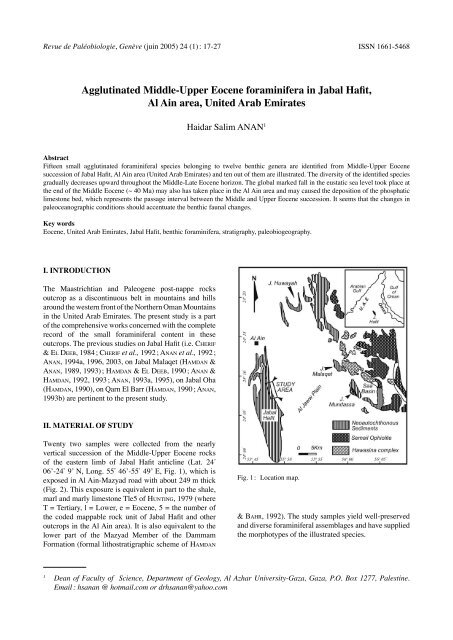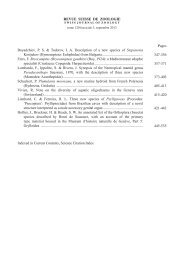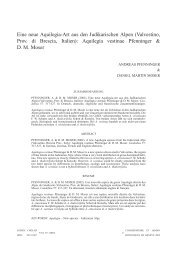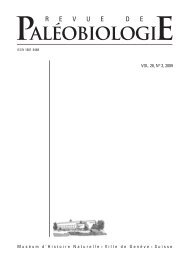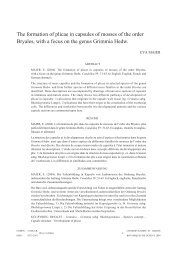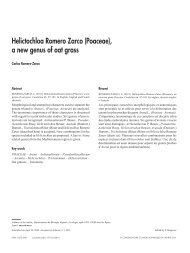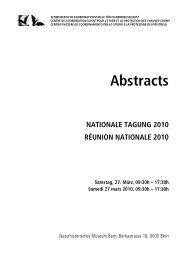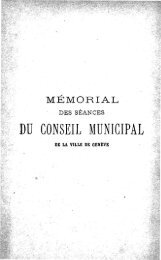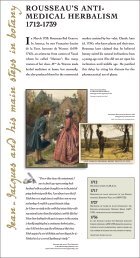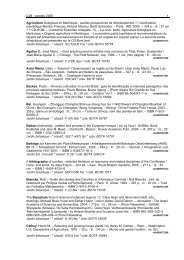Agglutinated Middle-Upper Eocene foraminifera in Jabal Hafit, Al ...
Agglutinated Middle-Upper Eocene foraminifera in Jabal Hafit, Al ...
Agglutinated Middle-Upper Eocene foraminifera in Jabal Hafit, Al ...
Create successful ePaper yourself
Turn your PDF publications into a flip-book with our unique Google optimized e-Paper software.
Revue de Paléobiologie, Genève (ju<strong>in</strong> 2005) 24 (1) : 17-27<br />
<strong>Agglut<strong>in</strong>ated</strong> <strong>Middle</strong>-<strong>Upper</strong> <strong>Eocene</strong> <strong>foram<strong>in</strong>ifera</strong> <strong>in</strong> <strong>Jabal</strong> <strong>Hafit</strong>,<br />
<strong>Al</strong> A<strong>in</strong> area, United Arab Emirates<br />
Haidar Salim ANAN 1<br />
ISSN 1661-5468<br />
Abstract<br />
Fifteen small agglut<strong>in</strong>ated <strong>foram<strong>in</strong>ifera</strong>l species belong<strong>in</strong>g to twelve benthic genera are identified from <strong>Middle</strong>-<strong>Upper</strong> <strong>Eocene</strong><br />
succession of <strong>Jabal</strong> <strong>Hafit</strong>, <strong>Al</strong> A<strong>in</strong> area (United Arab Emirates) and ten out of them are illustrated. The diversity of the identified species<br />
gradually decreases upward throughout the <strong>Middle</strong>-Late <strong>Eocene</strong> horizon. The global marked fall <strong>in</strong> the eustatic sea level took place at<br />
the end of the <strong>Middle</strong> <strong>Eocene</strong> (~ 40 Ma) may also has taken place <strong>in</strong> the <strong>Al</strong> A<strong>in</strong> area and may caused the deposition of the phosphatic<br />
limestone bed, which represents the passage <strong>in</strong>terval between the <strong>Middle</strong> and <strong>Upper</strong> <strong>Eocene</strong> succession. It seems that the changes <strong>in</strong><br />
paleoceanographic conditions should accentuate the benthic faunal changes.<br />
Key words<br />
<strong>Eocene</strong>, United Arab Emirates, <strong>Jabal</strong> <strong>Hafit</strong>, benthic <strong>foram<strong>in</strong>ifera</strong>, stratigraphy, paleobiogeography.<br />
I. INTRODUCTION<br />
The Maastrichtian and Paleogene post-nappe rocks<br />
outcrop as a discont<strong>in</strong>uous belt <strong>in</strong> mounta<strong>in</strong>s and hills<br />
around the western front of the Northern Oman Mounta<strong>in</strong>s<br />
<strong>in</strong> the United Arab Emirates. The present study is a part<br />
of the comprehensive works concerned with the complete<br />
record of the small <strong>foram<strong>in</strong>ifera</strong>l content <strong>in</strong> these<br />
outcrops. The previous studies on <strong>Jabal</strong> <strong>Hafit</strong> (i.e. CHERIF<br />
& EL DEEB, 1984 ; CHERIF et al., 1992 ; ANAN et al., 1992 ;<br />
ANAN, 1994a, 1996, 2003, on <strong>Jabal</strong> Malaqet (HAMDAN &<br />
ANAN, 1989, 1993) ; HAMDAN & EL DEEB, 1990 ; ANAN &<br />
HAMDAN, 1992, 1993 ; ANAN, 1993a, 1995), on <strong>Jabal</strong> Oha<br />
(HAMDAN, 1990), on Qarn El Barr (HAMDAN, 1990 ; ANAN,<br />
1993b) are pert<strong>in</strong>ent to the present study.<br />
II. MATERIAL OF STUDY<br />
Twenty two samples were collected from the nearly<br />
vertical succession of the <strong>Middle</strong>-<strong>Upper</strong> <strong>Eocene</strong> rocks<br />
of the eastern limb of <strong>Jabal</strong> <strong>Hafit</strong> anticl<strong>in</strong>e (Lat. 24 °<br />
06ʼ-24 ° 9ʼ N, Long. 55 ° 46ʼ-55 ° 49ʼ E, Fig. 1), which is<br />
exposed <strong>in</strong> <strong>Al</strong> A<strong>in</strong>-Mazyad road with about 249 m thick<br />
(Fig. 2). This exposure is equivalent <strong>in</strong> part to the shale,<br />
marl and marly limestone Tle5 of HUNTING, 1979 (where<br />
T = Tertiary, l = Lower, e = <strong>Eocene</strong>, 5 = the number of<br />
the coded mappable rock unit of <strong>Jabal</strong> <strong>Hafit</strong> and other<br />
outcrops <strong>in</strong> the <strong>Al</strong> A<strong>in</strong> area). It is also equivalent to the<br />
lower part of the Mazyad Member of the Dammam<br />
Formation (formal lithostratigraphic scheme of HAMDAN<br />
Fig. 1 : Location map.<br />
& BAHR, 1992). The study samples yield well-preserved<br />
and diverse <strong>foram<strong>in</strong>ifera</strong>l assemblages and have supplied<br />
the morphotypes of the illustrated species.<br />
1 Dean of Faculty of Science, Department of Geology, <strong>Al</strong> Azhar University-Gaza, Gaza, P.O. Box 1277, Palest<strong>in</strong>e.<br />
Email : hsanan @ hotmail.com or drhsanan@yahoo.com
18 H. S. ANAN<br />
III. STRATIGRAPHY<br />
The disappearance of the <strong>Middle</strong> <strong>Eocene</strong> sp<strong>in</strong>ose planktic<br />
<strong>foram<strong>in</strong>ifera</strong>l genera (Truncorotaloides, Morozovella,<br />
Acar<strong>in</strong><strong>in</strong>a) is taken by many authors (i.e. TOUMARKINE &<br />
LUTERBACHER, 1985) to mark the <strong>Middle</strong>/<strong>Upper</strong> <strong>Eocene</strong><br />
boundary and drawn between the Truncorotaloides rohri<br />
Zone (P14) and the Globiger<strong>in</strong>atheka semi<strong>in</strong>voluta Zone<br />
(P15). The codified zones of BLOW (1969) are used here.<br />
The Late <strong>Eocene</strong> Turborotalia pseudoampliapertura<br />
Zone was <strong>in</strong>troduced by HAGGAG (1990) to separate<br />
the Truncorotaloides rohri Zone (P14) from the<br />
Globiger<strong>in</strong>atheka semi<strong>in</strong>voluta Zone (P15). STROUGO<br />
(1992) proposed to draw the base of the <strong>Upper</strong> <strong>Eocene</strong> at<br />
the base of the G. semi<strong>in</strong>voluta Zone thus relegat<strong>in</strong>g the<br />
T. pseudoampliapertura Zone to the latest <strong>Middle</strong> <strong>Eocene</strong><br />
(the latter zone is marked here by the proposed coded<br />
no. P14/15). This stratigraphical op<strong>in</strong>ion was adopted by<br />
ANAN et al. (1992), ANAN (1994b, 2003) and this study.<br />
The section under <strong>in</strong>vestigation (the Tle5 succession)<br />
is represented by four planktic <strong>foram<strong>in</strong>ifera</strong>l biozones,<br />
from base to top : the upper part of the <strong>Middle</strong> <strong>Eocene</strong><br />
Truncorotaloides rohri Zone (P14) and Turborotalia<br />
pseudoampliapertura Zone (P14/15) and the Late<br />
<strong>Eocene</strong> : Globiger<strong>in</strong>atheka semi<strong>in</strong>voluta Zone (P15) and<br />
Cribrohantken<strong>in</strong>a <strong>in</strong>flata Zone (P16). The phosphatic<br />
limestone bed (bed no.9, Fig. 2 ; about 25 m thick)<br />
represents the passage <strong>in</strong>terval between the <strong>Middle</strong> and<br />
<strong>Upper</strong> <strong>Eocene</strong> succession <strong>in</strong> the study section.<br />
IV. TAXONOMY<br />
Fifteen diagnostic and well-preserved small agglut<strong>in</strong>ated<br />
<strong>foram<strong>in</strong>ifera</strong>l species are identified <strong>in</strong> the study<br />
section. Ten of them are illustrated here (Plate I),<br />
while another three species Orbul<strong>in</strong>elloides arabicus,<br />
Marssonella hafitensis and Plect<strong>in</strong>a emiratensis were<br />
recently illustrated <strong>in</strong> ANAN (2003) as new species. The<br />
stratigraphic ranges of the identified species are shown<br />
<strong>in</strong> Fig. 3.<br />
Order Foram<strong>in</strong>iferida EICHWALD, 1830<br />
Suborder Textulari<strong>in</strong>a DELAGE & HEROUARD, 1896<br />
Superfamily Astrorhizacea BRADY, 1881<br />
Family Bathysiphonidae AVNIMELECH, 1952<br />
Genus Bathysiphon SARS, 1872<br />
Type species : Bathysiphon filiformis SARS, 1872<br />
Bathysiphon eocenicus CUSHMAN & HANNA, 1927<br />
Pl. I, fig. 1<br />
1927. Bathysiphon eocenica CUSHMAN & HANNA ,p. 210, p1.<br />
13, figs 2, 3.<br />
1951. Bathysiphon eocenica CUSHMAN & HANNA. - CUSHMAN &<br />
STAINFORTH, p. 142, p1. 25, fig. 4.<br />
1975. Bathysiphon eocenicus CUSHMAN & HANNA. - BRAGA &<br />
GRÜNIG, p. 102, fig. 5.<br />
1994. Bathysiphon eocenicus CUSHMAN & HANNA. - BOLLI et<br />
al., p. 65, fig. 18.3.<br />
1996. Bathysiphon eocenica CUSHMAN & HANNA.- ANAN, p.<br />
149, fig. 3.1.<br />
Fig. 2 : Schematic diagram of the study section, Tle5 (the lower part of Mazyad Member, Dammam Formation), eastern limb of <strong>Jabal</strong><br />
<strong>Hafit</strong>.
<strong>Agglut<strong>in</strong>ated</strong> <strong>Middle</strong>-<strong>Upper</strong> <strong>Eocene</strong> <strong>foram<strong>in</strong>ifera</strong> <strong>in</strong> <strong>Jabal</strong> <strong>Hafit</strong>, <strong>Al</strong> A<strong>in</strong> area 19<br />
Fig. 3 : The stratigraphic ranges of the identified M/U <strong>Eocene</strong><br />
agglut<strong>in</strong>ated <strong>foram<strong>in</strong>ifera</strong>l species.<br />
1997. Bathysiphon eocenica CUSHMAN & HANNA. - HUSSEIN, p.<br />
108, fig. 3.1.<br />
2000. Bathysiphon sp. 2 - ABUL-NASR, p. 72, fig. 16.5.<br />
The species was orig<strong>in</strong>ally described from the <strong>Eocene</strong> of<br />
California, USA. It is also recorded from the <strong>Eocene</strong> of<br />
Ecuador (CUSHMAN & STAINFORTH, 1951), Italy (BRAGA &<br />
GRÜNIG, 1975), Tr<strong>in</strong>idad (BOLLI et al., 1994) and Egypt<br />
(ANAN, 1994b ; HUSSEIN, 1997).<br />
This species was recorded <strong>in</strong> the Early <strong>Eocene</strong> (P9) of<br />
<strong>Jabal</strong> <strong>Hafit</strong> by ANAN (1996). It occurs also <strong>in</strong> the <strong>Middle</strong><br />
and <strong>Upper</strong> <strong>Eocene</strong> (P14-P16) of <strong>Jabal</strong> <strong>Hafit</strong> <strong>in</strong> the study<br />
section.<br />
Bathysiphon eocenicus has a cosmopolitan geographic<br />
distribution.<br />
Bathysiphon saidi (ANAN, 1994)<br />
Pl. I, fig. 2<br />
1994b. Rhabdamm<strong>in</strong>a saidi ANAN, p. 218, fig. 8.1<br />
1997. Bathysiphon abbassi HUSSEIN, p. 109, fig. 3.2.<br />
2000. Bathysiphon sp.1 - ABUL-NASR, p. 72, fig. 16.4.<br />
The species is regarded here to belong to the genus<br />
Bathysiphon due to its straight unbranched elongate tube<br />
and wider stratigraphic range (Up. Triassic-Holocene) than<br />
the restricted Holocene time of the genus Rhabdamm<strong>in</strong>a<br />
SARS, 1869 (LOEBLICH & TAPPAN, 1988, p. 24).<br />
Bathysiphon saidi differs from B. eocenicus <strong>in</strong> hav<strong>in</strong>g<br />
rough agglut<strong>in</strong>ated surface with cemented coarse<br />
fragmented sand gra<strong>in</strong>s. On the other hand, the coarsely<br />
agglut<strong>in</strong>ated sand gra<strong>in</strong>s B. abbassi of HUSSEIN (1997)<br />
and also B. sp.1 of ABUL-NASR (2000) closely conspecific<br />
with B. saidi (ANAN, 1994b).<br />
Bathysiphon saidi was orig<strong>in</strong>ally described from the top<br />
<strong>Middle</strong> - <strong>Upper</strong> <strong>Eocene</strong> of Egypt, while it is recorded<br />
only from the top <strong>Middle</strong> <strong>Eocene</strong> (P 14) of <strong>Jabal</strong> <strong>Hafit</strong>.<br />
Family Saccamm<strong>in</strong>idae BARDY, 1884<br />
Subfamily Thuramm<strong>in</strong><strong>in</strong>ae A. D. MIKLUKHO-MAKLAY,<br />
1963<br />
Genus Orbul<strong>in</strong>elloides SAIDOVA, 1975<br />
Type species : Orbul<strong>in</strong>oides agglut<strong>in</strong>atus SAIDOVA, 1970<br />
Orbul<strong>in</strong>elloides arabicus ANAN, 2003<br />
2003. Orbul<strong>in</strong>elloides arabicus ANAN, p. 531, fig. 4.1.<br />
This species is characterized by its spherical to<br />
subspherical coarsely agglut<strong>in</strong>ated test. It occurs <strong>in</strong> the<br />
top <strong>Middle</strong> <strong>Eocene</strong> (P14) to middle Late <strong>Eocene</strong> (P16)<br />
of <strong>Jabal</strong> <strong>Hafit</strong>.<br />
Superfamily Rzehak<strong>in</strong>acea CUSHMAN, 1933<br />
Family Rzehak<strong>in</strong>idae CUSHMAN, 1933<br />
Genus Miliamm<strong>in</strong>a HERON-ALLEN & EARLAND, 1930<br />
Type species : Miliol<strong>in</strong>a oblonga (MONTAGU) var.<br />
arenacea CHAPMAN, 1916<br />
Miliamm<strong>in</strong>a kenawyi ANAN, 1994<br />
Pl. I, fig. 3<br />
1994b. Miliamm<strong>in</strong>a kenawyi ANAN, p. 218, fig. 8.2.<br />
The species is characterized by its f<strong>in</strong>e agglut<strong>in</strong>ated<br />
smooth wall <strong>in</strong> loose qu<strong>in</strong>quelocul<strong>in</strong>e arrangement with<br />
half coil chambers. It was orig<strong>in</strong>ally described from the<br />
top <strong>Middle</strong> <strong>Eocene</strong> (P14) to early Late <strong>Eocene</strong> (P15) of<br />
Egypt.<br />
This species is recorded only <strong>in</strong> the top <strong>Middle</strong> <strong>Eocene</strong><br />
(P14/15) of <strong>Jabal</strong> <strong>Hafit</strong>.
20 H. S. ANAN<br />
Superfamily Lituolacea de BLAINVILLE, 1827<br />
Family Haplophragmoididae MAYNC, 1952<br />
Genus Haplophragmoides CUSHMAN, 1910<br />
Type species : Nonion<strong>in</strong>a canariensis dʼORBIGNY, 1839<br />
Haplophragmoides walteri (GRZYBOWSKI, 1898)<br />
Pl. I, fig. 4<br />
1898. Trochamm<strong>in</strong>a walteri GRZYBOWSKI, p. 290, p1. 11, fig.<br />
31.<br />
1981. Haplophragmoides walteri (GRZYBOWSKI).- MORGIEL &<br />
OLSZEWSKA, p. 10, p1. 3, fig. 15.<br />
1982. Haplophragmoides walteri (GRZYBOWSKI).- MILLER et<br />
al., p. 20, p1. 2, fig. 7.<br />
The species is characterized by its <strong>in</strong>volutes planispiral<br />
test, agglut<strong>in</strong>ated wall with f<strong>in</strong>e quartz gra<strong>in</strong>s with<br />
siliceous cement, small umbonal depression on both<br />
sides, elongate triangular chambers <strong>in</strong>creas<strong>in</strong>g slowly <strong>in</strong><br />
size, slightly depressed and curved sutures.<br />
In the Polish External Carpathians the species ranges<br />
from Senonian to <strong>Eocene</strong> (MORGIEL & OLSZEWSKA, 1981)<br />
and from Early to <strong>Middle</strong> <strong>Eocene</strong> <strong>in</strong> Labrador Sea, North<br />
Atlantic (MILLER et al., 1982).<br />
In this study, the species occurs <strong>in</strong> the top <strong>Middle</strong> <strong>Eocene</strong><br />
(P14) of <strong>Jabal</strong> <strong>Hafit</strong>.<br />
Genus Ammobaculites CUSHMAN, 1910<br />
Type species : Spirol<strong>in</strong>a agglut<strong>in</strong>ans dʼORBIGNY, 1846<br />
Ammobaculites cubensis CUSHMAN & BERMUDEZ, 1937<br />
Pl. I, fig. 5<br />
1937. Ammobaculites cubensis CUSHMAN & BERMUDEZ, p. 106,<br />
p1. 16, figs 4, 16-18.<br />
1955. Ammobaculites cubensis CUSHMAN & BERMUDEZ.-<br />
ANSARY, p. 17, p1. 1, fig. 1.<br />
1994. Ammobaculites cubensis CUSHMAN & BERMUDEZ.- BOLLI<br />
et al., p. 325, fig. 62.3.<br />
The species was orig<strong>in</strong>ally described from the <strong>Eocene</strong><br />
of Cuba by CUSHMAN & BERMUDEZ (1937) and from the<br />
<strong>Middle</strong> and <strong>Upper</strong> <strong>Eocene</strong> of Egypt (ANSARY, 1955) and<br />
Tr<strong>in</strong>idad (BOLLI et al., 1994).<br />
It is recorded here <strong>in</strong> the top <strong>Middle</strong> <strong>Eocene</strong> (P14) of<br />
<strong>Jabal</strong> <strong>Hafit</strong>.<br />
Superfamily Spiroplectamm<strong>in</strong>acea CUSHMAN, 1927<br />
Family Spiroplectamm<strong>in</strong>idae CUSHMAN, 1927<br />
Subfamily Spiroplectamm<strong>in</strong><strong>in</strong>ae CUSHMAN, 1927<br />
Genus Spiroplect<strong>in</strong>ella KISELʼMAN, 1972<br />
Type species : Spiroplecta wrightii SILVESTRI, 1903<br />
Spiroplect<strong>in</strong>ella nuttalli (LALICKER, 1935)<br />
Pl. I, fig. 6<br />
1935. Spiroplectamm<strong>in</strong>a nuttalli LALICKER, p. 43, p1. 6, figs<br />
3, 4.<br />
1951. Spiroplectamm<strong>in</strong>a nuttalli LALICKER.- CUSHMAN &<br />
STAINFORTH, p. 143, p1. 25, figs 19, 20.<br />
1955. Boliv<strong>in</strong>opsis nuttalli (LALICKER) - ANSARY, p. 19, p1. 1,<br />
fig. 7.<br />
1997. Boliv<strong>in</strong>opsis nuttalli (LALICKER).- HUSSEIN, p. 11, fig.<br />
3.10.<br />
2000. Boliv<strong>in</strong>opsis cf. nuttalli (LALICKER).- ABUL-NASR, p. 72,<br />
fig. 14.11.<br />
LOEBLICH & TAPPAN (1988, p. 111, 112) noted that<br />
the biserial stage of the genus Spiroplect<strong>in</strong>ella is<br />
characterized by its lozenge shaped <strong>in</strong> cross section and<br />
may have a marg<strong>in</strong>al keel, while it is long and nearly<br />
constant width throughout <strong>in</strong> Boliv<strong>in</strong>opsis and ovoid <strong>in</strong><br />
Spiroplectamm<strong>in</strong>a. Hence, the species is related here to<br />
the genus Spiroplect<strong>in</strong>ella.<br />
The species was orig<strong>in</strong>ally described from the <strong>Eocene</strong> of<br />
Venezuela by LALICKER (1935), then <strong>in</strong> the same horizon<br />
of Ecuador (CUSHMAN & STAINFORTH, 1951) and Egypt<br />
(ANSARY, 1955 ; HUSSEIN, 1997 ; ABUL-NASR, 2000).<br />
It is recorded here from the top <strong>Middle</strong> to early Late<br />
<strong>Eocene</strong> (P14 - P15) of <strong>Jabal</strong> <strong>Hafit</strong>.<br />
Subfamily Vulvul<strong>in</strong><strong>in</strong>ae SAIDOVA, 1981<br />
Genus Vulvul<strong>in</strong>a dʼORBIGNY, 1826<br />
Type species : Vulvul<strong>in</strong>a capreolus CUSHMAN, 1928<br />
Vulvul<strong>in</strong>a haer<strong>in</strong>gensis (GÜMBEL, 1868)<br />
1868. Venil<strong>in</strong>a haer<strong>in</strong>gensis GÜMBEL, p. 71, pl. 2, fig. 84.<br />
1975. Vulvul<strong>in</strong>a haer<strong>in</strong>gensis (GÜMBEL).- PROTO DECIMA & de<br />
BIASE, p. 91, pl. 1, figs 4, 23.<br />
1975. Vulvul<strong>in</strong>a haer<strong>in</strong>gensis (GÜMBEL).- BRAGA & GRÜNIG,<br />
p. 102, pl. 5, fig. 5.<br />
1978. Vulvul<strong>in</strong>a haer<strong>in</strong>gensis (GÜMBEL).- PROTO DECIMA &<br />
BOLLI, p. 797, pl. 1, fig. 5.<br />
1988. Vulvul<strong>in</strong>a haer<strong>in</strong>gensis (GÜMBEL).- PARISI & COCCIONI, p.<br />
103, pl. 1, figs 8, 9.<br />
1996. Vulvul<strong>in</strong>a haer<strong>in</strong>gensis (GÜMBEL).- ANAN, p. 149, fig.<br />
3.3.<br />
The species was recorded <strong>in</strong> Italy (PROTO DECIMA & de<br />
BIASE, 1975 ; BRAGA & GRÜNIG, 1975 ; PARISI & COCCIONI,<br />
1988) and also <strong>in</strong> South Atlantic, DSDP Leg 40, west<br />
coast of Africa (PROTO DECIMA & BOLLI, 1978).<br />
The species was recorded <strong>in</strong> the Early <strong>Eocene</strong> (P9) of<br />
<strong>Jabal</strong> <strong>Hafit</strong> (ANAN, 1996). It occurs also <strong>in</strong> the <strong>Middle</strong>-<br />
Late <strong>Eocene</strong> (P14-P15) of the study section.<br />
Vulvul<strong>in</strong>a jarvisi CUSHMAN, 1932<br />
Pl. I, fig. 7<br />
1932. Vulvul<strong>in</strong>a jarvisi CUSHMAN, p. 84, pl. 10, fig. 20.<br />
1976. Vulvul<strong>in</strong>a jarvisi CUSHMAN.- BERGGREN & AUBERT, p.<br />
314, pl. 1, fig. 1.
<strong>Agglut<strong>in</strong>ated</strong> <strong>Middle</strong>-<strong>Upper</strong> <strong>Eocene</strong> <strong>foram<strong>in</strong>ifera</strong> <strong>in</strong> <strong>Jabal</strong> <strong>Hafit</strong>, <strong>Al</strong> A<strong>in</strong> area 21<br />
The species has been recorded <strong>in</strong> mid-Tertiary rocks<br />
of some Caribbean Sea (CUSHMAN & RENZ, 1941 <strong>in</strong><br />
Venezuela, CUSHMAN & STAINFORTH, 1945 <strong>in</strong> Tr<strong>in</strong>idad)<br />
and also North Atlantic region (BERGGREN & AUBERT,<br />
1976).<br />
It is recorded only <strong>in</strong> the early Late <strong>Eocene</strong> (P15) of <strong>Jabal</strong><br />
<strong>Hafit</strong>.<br />
Superfamily Verneuil<strong>in</strong>acea CUSHMAN, 1911<br />
Family Prolixoplectidae LOEBLICH & TAPPAN, 1985<br />
Genus Plect<strong>in</strong>a MARSSON, 1878<br />
Type species : Gaudry<strong>in</strong>a ruthenica REUSS, 1851<br />
Plect<strong>in</strong>a emiratensis ANAN, 2003<br />
2003. Plect<strong>in</strong>a emiratensis ANAN, p.534, fig. 4.2.<br />
The species is characterized by its subconical and short<br />
test, coarse-gra<strong>in</strong>ed surface, subterm<strong>in</strong>al and traverse<br />
elongate slit aperture on the apertural face of the last<br />
formed chamber.<br />
This species occurs <strong>in</strong> the top <strong>Middle</strong> <strong>Eocene</strong> (P14) of<br />
<strong>Jabal</strong> <strong>Hafit</strong>.<br />
Family Tritaxiidae PLOTNIKOVA, 1979<br />
Genus Tritaxia REUSS, 1860<br />
Type species : Textularia tricar<strong>in</strong>ata REUSS, 1844<br />
Tritaxia alp<strong>in</strong>a (CUSHMAN, 1936)<br />
Pl. I, fig. 8<br />
1936. Clavul<strong>in</strong>oides alp<strong>in</strong>a CUSHMAN, p. 22, pl. 3, fig. 16.<br />
1975. Tritaxia alp<strong>in</strong>a (CUSHMAN).- PROTO DECIMA & de BIASE,<br />
p. 91, pl.1, fig. 12.<br />
The species was recorded by PROTO DECIMA & de BIASE<br />
(1975) to range from Early to <strong>Middle</strong> <strong>Eocene</strong> of Possagno<br />
section of Italy.<br />
In this study, it is recorded only from the Late <strong>Eocene</strong><br />
(P15-P16) of <strong>Jabal</strong> <strong>Hafit</strong>.<br />
Superfamily Textulariacea EHRENBERG, 1838<br />
Family Eggerellidae CUSHMAN, 1937<br />
Subfamily Dorothi<strong>in</strong>ae BALAKHMATOVA, 1972<br />
Genus Dorothia PLUMMER, 1931<br />
Type species : Gaudry<strong>in</strong>a bullata CARSEY, 1931<br />
Dorothia nacataensis (WHITE, 1929)<br />
Pl. I, fig. 9<br />
1929. Textularia nacataensis WHITE, p. 31, pl. 4, fig. 2.<br />
1978. Marssonella nacataensis (WHITE) - PROTO DECIMA &<br />
BOLLI, p. 794, pl. 1, fig. 15c.<br />
LOEBLICH & TAPPAN (1988, p. 169) noted that the biserial<br />
stage of Dorothia is <strong>in</strong>creas<strong>in</strong>g very slowly <strong>in</strong> size, so<br />
that test has nearly parallel sides and is circular <strong>in</strong> cross<br />
section, while it is rapidly <strong>in</strong>creas<strong>in</strong>g diameter and<br />
conical <strong>in</strong> Marssonella. Hence, it is related here to the<br />
genus Dorothia.<br />
The species was orig<strong>in</strong>ally described from the <strong>Eocene</strong><br />
rocks of the Tampico Embayment of Mexico. It was<br />
also recorded by PROTO DECIMA & BOLLI (1978) from the<br />
Paleocene of southeast Atlantic DSDP Leg 40, west coast<br />
of Africa.<br />
In this study, the species is recorded <strong>in</strong> the top <strong>Middle</strong> to<br />
Late <strong>Eocene</strong> (P14 - P16) of <strong>Jabal</strong> <strong>Hafit</strong>.<br />
Genus Marssonella CUSHMAN, 1933<br />
Type species : Gaudry<strong>in</strong>a oxycona REUSS, 1860<br />
Marssonella hafitensis ANAN, 2003<br />
2003. Marssonella hafitensis ANAN, p. 535, fig. 4.3.<br />
Marssonella hafitensis is recognized from the <strong>Upper</strong><br />
Cretaceous-Paleocene M. oxycona by its nearly equal<br />
length and breadth test, coarse- gra<strong>in</strong>ed wall and concave<br />
term<strong>in</strong>al face.<br />
The species is recorded from the top <strong>Middle</strong> to Late<br />
<strong>Eocene</strong> (P14 - P16) of <strong>Jabal</strong> <strong>Hafit</strong>.<br />
Family Textulariidae EHRENBERG, 1838<br />
Subfamily Textulari<strong>in</strong>ae EHRENBERG, 1838<br />
Genus Textularia DEFRANCE, 1824<br />
Type species : Textularia sagittula DEFRANCE, 1824<br />
Textularia communis (dʼORBIGNY, 1826)<br />
Pl. I, fig. 10<br />
1826. Textilaria communis dʼORBIGNY, p. 263.<br />
1955. Textularia communis (dʼORBIGNY).- ANSARY, p. 21, pl. 1,<br />
fig. 8.<br />
1992. Textularia communis (dʼORBIGNY).- CHERIF et al., p. 46,<br />
pl. 1, fig. 7.<br />
The species was recorded <strong>in</strong> the <strong>Upper</strong> <strong>Eocene</strong> rocks of<br />
Egypt (ANSARY, 1955).<br />
CHERIF et al., (1992) have recorded this species from<br />
the Oligocene of <strong>Jabal</strong> <strong>Hafit</strong>, while it occurs <strong>in</strong> the top<br />
<strong>Middle</strong> <strong>Eocene</strong> (P14/15) of the study section. The rare<br />
found specimens are broken with miss<strong>in</strong>g <strong>in</strong>itial part.<br />
Textularia plummerae LALICKER, 1935<br />
1935. Textularia plummerae LALICKER, p. 50, pl. 6, fig. 10.<br />
1975. Textularia plummerae LALICKER.- PROTO DECIMA & de<br />
BIASE, p. 91, pl. 1, fig. 6.<br />
1989. Textularia plummerae LALICKER.- HULSBOS et al., p. 268,<br />
pl. 1, fig. 7.
22 H. S. ANAN<br />
The species was recorded from the Paleocene to <strong>Middle</strong><br />
<strong>Eocene</strong> of Italy (PROTO DECIMA & de BIASE, 1975) and<br />
from the Lower <strong>Eocene</strong> of Norwegian Sea, DSDP Site<br />
338 (HULSBOS et al., 1989).<br />
It occurs <strong>in</strong> the top <strong>Middle</strong> <strong>Eocene</strong> (P14 and P14/15) of<br />
<strong>Jabal</strong> <strong>Hafit</strong>.<br />
V. TEMPORAL DISTRIBUTION AROUND M/U<br />
EOCENE BOUNDARY<br />
Accord<strong>in</strong>g to many authors (ex. VAIL et al., 1977 ; HAQ et<br />
al., 1987) a marked fall <strong>in</strong> the eustatic sea level took place<br />
at the end of the <strong>Middle</strong> <strong>Eocene</strong> (39-40 Ma). This global<br />
regression may also has taken place <strong>in</strong> the <strong>Al</strong> A<strong>in</strong> area. It<br />
may caused the deposition of the phosphatic limestone bed<br />
(bed no. 9, Fig. 2 ; about 25 m thick), which represents the<br />
passage <strong>in</strong>terval between the <strong>Middle</strong> and <strong>Upper</strong> <strong>Eocene</strong><br />
succession <strong>in</strong> the study section. Previously, ABUL-NASR<br />
& THUNELL (1987) noted that the concentration of clastic<br />
phosphatic sediment be<strong>in</strong>g a function of rework<strong>in</strong>g dur<strong>in</strong>g<br />
times of lowered sea level.<br />
The temporal distribution of the fifteen identified species<br />
<strong>in</strong> the <strong>Middle</strong>-<strong>Upper</strong> <strong>Eocene</strong> succession of the study<br />
section is shown <strong>in</strong> Fig. 3. The follow<strong>in</strong>g remarks are<br />
presented :<br />
1. The diversity of the identified species gradually<br />
decreases upward throughout the M/U <strong>Eocene</strong><br />
succession. About 87 % of the identified species<br />
(13/15 species) are recorded <strong>in</strong> the <strong>Middle</strong> <strong>Eocene</strong><br />
compared to 53 % (8/15 species) <strong>in</strong> the Late <strong>Eocene</strong>.<br />
It is <strong>in</strong>terest<strong>in</strong>g to note that the M/U <strong>Eocene</strong> boundary<br />
<strong>in</strong> Egypt (ANAN, 1994b) is also marked by a sudden<br />
fall <strong>in</strong> abundance and/or diversity of the <strong>foram<strong>in</strong>ifera</strong>l<br />
assemblage.<br />
2. Seven out of the identified species are recorded only<br />
from the <strong>Middle</strong> <strong>Eocene</strong> zones (P14 and P14/15).<br />
These species are : Ammobaculites cubensis,<br />
Bathysiphon saidi, Haplophragmoides walteri,<br />
Miliamm<strong>in</strong>a kenawyi, Plect<strong>in</strong>a emiratensis and<br />
Textularia plummerae, T. communis.<br />
3. Two species Tritaxia alp<strong>in</strong>a and Vulvul<strong>in</strong>a jarvisi are<br />
restricted to the Late <strong>Eocene</strong> (P15 and P16).<br />
4. Six out of thirteen <strong>Middle</strong> <strong>Eocene</strong> species cont<strong>in</strong>ue<br />
<strong>in</strong>to the Late <strong>Eocene</strong> (P15 and P16). These are :<br />
Bathysiphon eocenicus, Dorothia nacataensis,<br />
Marssonella hafitensis, Orbul<strong>in</strong>elloides arabicus,<br />
Spiroplect<strong>in</strong>ella nuttalli and Vulvul<strong>in</strong>a haer<strong>in</strong>gensis.<br />
5. Four species B. eocenicus, O. arabicus, M. hafitensis<br />
and D. nacataensis, among other species, have a long<br />
ranged throughout the M/U <strong>Eocene</strong> horizon, and<br />
represent the Tle5 succession.<br />
VI. PALEOBIOGEOGRAPHY AND<br />
PALEOECOLOGY<br />
The paleogeographic reconstruction maps of MOORE et<br />
al. (1978) and ZACHOS et al. (1993) for the <strong>Middle</strong>-Late<br />
<strong>Eocene</strong> show that the Tethyan realm extended to the<br />
southeast and had been connected with the Indo-Pacific<br />
realm via a seaway separat<strong>in</strong>g Arabia from Iran-India<br />
region. At that time, the North America and South<br />
America were separated and the Atlantic and Pacific<br />
realms connected by another seaway. On the other<br />
hand, CHERIF & EL DEEB (1984) noted that close to the<br />
end of the <strong>Middle</strong> <strong>Eocene</strong> the previously arid climates<br />
became markedly wetter and seems also to have been<br />
accompanied by a cool<strong>in</strong>g of the water temperature.<br />
They also suggested that the climatic changes <strong>in</strong>ferred<br />
from the <strong>Hafit</strong> area seem to have been widespread, at<br />
least <strong>in</strong> parts of the <strong>Middle</strong> East. KELLER et al. (1987)<br />
noted that the <strong>Middle</strong>/Late <strong>Eocene</strong> boundary is marked<br />
by expansion of cooler water assemblages and a major<br />
ext<strong>in</strong>ction event among warmer water species <strong>in</strong>volv<strong>in</strong>g<br />
80 % of the <strong>in</strong>dividuals of the population, or 23 % of the<br />
species population.<br />
Table I shows the identified fifteen agglut<strong>in</strong>ated<br />
<strong>foram<strong>in</strong>ifera</strong>l species <strong>in</strong> the <strong>Middle</strong>-<strong>Upper</strong> <strong>Eocene</strong><br />
succession from <strong>Jabal</strong> <strong>Hafit</strong>, as well as, the other<br />
recorded species from Egypt, Italy, Caribbean region and<br />
Ecuador by different authors. The follow<strong>in</strong>g remarks can<br />
be presented :<br />
1. The study section yields 15 agglut<strong>in</strong>ated <strong>foram<strong>in</strong>ifera</strong>l<br />
species around the M/U <strong>Eocene</strong> boundary, compared<br />
to 13 species from Egypt, 19 from Italy, 17 from<br />
Caribbean region and 13 species from Ecuador<br />
(Pacific realm).<br />
2. Seven species : Ammobaculites cubensis, Bathysiphon<br />
eocenicus, B. saidi, Haplophragmoides walteri,<br />
Miliamm<strong>in</strong>a kenawyi, Spiroplect<strong>in</strong>ella nuttalli and<br />
Textularia communis are recorded from both <strong>Jabal</strong><br />
<strong>Hafit</strong> (UAE) and Egypt <strong>in</strong> one hand, while only<br />
four species Ammobaculites cubensis, A. subglabra,<br />
Bathysiphon eocenicus and Textularia recta are<br />
recorded from both Egypt and Italy (Tethyan realm)<br />
<strong>in</strong> the other hand.<br />
3. Eleven species Dorothia colei, D. nipeenis,<br />
Gaudry<strong>in</strong>a pseudocoll<strong>in</strong>s, Haplophragmoides<br />
emaciatus, Karreriella hantkeniana, K. subcyl<strong>in</strong>drica,<br />
Lituotuba navetensis, Mart<strong>in</strong>ottiella petrosa,<br />
Plect<strong>in</strong>a dalmat<strong>in</strong>a, Pseudoclavul<strong>in</strong>a tr<strong>in</strong>itatensis<br />
and Spiroplectamm<strong>in</strong>a tr<strong>in</strong>itatensis are endemic to<br />
Caribbean region.<br />
4. Three species Ammobaculites cubensis, Bathysiphon<br />
eocenicus and Haplophragmoides emaciatus are<br />
recorded <strong>in</strong> both the Tethyan and Caribbean regions.<br />
5. Two species Ammodiscus <strong>in</strong>certus and Bathysiphon<br />
eocenicus are recorded from both the Caribbean<br />
region and Ecuador.<br />
6. Only one species Spiroplect<strong>in</strong>ella nuttalli is recorded<br />
<strong>in</strong> UAE, Egypt and Ecuador.
Table I : <strong>Middle</strong>/<strong>Upper</strong> <strong>Eocene</strong> agglut<strong>in</strong>ated <strong>foram<strong>in</strong>ifera</strong>l species <strong>in</strong> <strong>Jabal</strong> <strong>Hafit</strong> (UAE), Egypt, Italy, Caribbean region and Ecuador.<br />
sp.<br />
no.<br />
<strong>Agglut<strong>in</strong>ated</strong> <strong>Middle</strong>-<strong>Upper</strong> <strong>Eocene</strong> <strong>foram<strong>in</strong>ifera</strong> <strong>in</strong> <strong>Jabal</strong> <strong>Hafit</strong>, <strong>Al</strong> A<strong>in</strong> area 23<br />
AGGLUTINATED FORAMINIFERAL SPECIES AROUND THE<br />
M/U EOCENE BOUNDARY IN JABAL HAFIT(UAE) AND OTHER<br />
LOCALITIES<br />
(1) (2) (3) (4) (5)<br />
1 Ammobculites cubensis CUSHMAN & BERMUDEZ, 1937 x x x x -<br />
2 subglabra (GÜMBEL, 1898) - x x - -<br />
3 Ammodiscus glabratus CUSHMAN & JARVIS, 1928 - - x - -<br />
4 <strong>in</strong>certus (dʼORBIGNY, 1839) - - - x x<br />
5 Ammospirata mexicana (CUSHMAN, 1933) - - - - x<br />
6 Ammovertella retrorsa CUSHMAN & STAINFORTH, 1945<br />
7 Bathysiphon eocenicus CUSHMAN & HANNA, 1927 x x x x x<br />
8 saidi (ANAN, 1994) x x - - -<br />
9 samanica (BERRY, 1928) - - - - x<br />
10 Cyclam<strong>in</strong>a acutidorsata (HANTKEN, 1975) - - x - -<br />
11 cf. pacifica BECK, 1943 - - - - x<br />
12 Cyl<strong>in</strong>droclavul<strong>in</strong>a colomi HANG,1956 - - x - -<br />
13 Dorothia colei (NUTTALL, 1932) - - - x -<br />
14 fallax HANG,1954 - - x - -<br />
15 nacataensis (WHITE, 1929) x - - - -<br />
16 nipeensis KEIJZER, 1945 - - - x -<br />
17 traubi HANG, 1956 - - x - -<br />
18 Gaudry<strong>in</strong>a jacksonensis CUSHMAN, 1926 - - - x -<br />
19 pseudocoll<strong>in</strong>s CUSHMAN & STAINFORTH, 1945 - - - x -<br />
20 Glomospira charoidescorona CUSHMAN & JARVIES,1928 - - x - -<br />
21 Haplophragmoides car<strong>in</strong>atum CUSHMAN & RENZ, 1941 - - x - x<br />
22 emaciatus BRADY, 1908 - x - x -<br />
23 cf. hetha BERRY, 1932 - - - - x<br />
24 subglobosus SARS, 1868 - x - - -<br />
25 walteri (GRZYBOWSKI, 1868) x - - - -<br />
26 Karreriella hantkeniana CUSHMAN, 1936 - - - x -<br />
27 subcyl<strong>in</strong>drica (NUTTALL, 1928) - - - x -<br />
28 Lituotuba navetensis CUSHMAN, & RENZ, 1948 - - - x -<br />
29 Marssonella hafitensis ANAN, 2003 x - - - -<br />
30 Mart<strong>in</strong>ottiella petrosa (CUSHMAN & BERMUDEZ, 1937) - - - x -<br />
31 Miliamm<strong>in</strong>a kenawyi ANAN, 1994 x x - - -<br />
32 Orbul<strong>in</strong>elloides arabicus ANAN, 2003 x - - - -<br />
33 Plect<strong>in</strong>a dalmat<strong>in</strong>a (SCHBERT, 1911) - - x - -<br />
34 emiratensis ANAN, 2003 x - - - -<br />
35 nuttalli CUSHMAN & STAINFORTH, 1951 - - - - x<br />
36 tr<strong>in</strong>itatensis CUSHMAN & RENZ, 1948 - - - x -<br />
37 Psammosphaera eocenica CUSHMAN & STAINFORTH, 1951 - - - - x<br />
38 Pseudoclavul<strong>in</strong>a tr<strong>in</strong>itatensis CUSHMAN & RENZ, 1948 - - - x -<br />
39 Spiroplectamm<strong>in</strong>a eocenica (CUSHMAN & BARKSDALE, 1930) - - - - x<br />
40 tr<strong>in</strong>itatensis CUHSMAN & RENZ,1948 - - - x -<br />
41 Spiroplect<strong>in</strong>ella nuttalli (LALICKER, 1935) x x - x x<br />
42 Techanitella archaeonitida STAINFORTH & STEVENSON, 1964 - - - - x<br />
43 Textularia communis (dʼORBIGNY, 1926) x x - - -<br />
44 concava KARRER, 1884 - x - - -<br />
45 fahmyi ANAN, 1994 - x - - -
24 H. S. ANAN<br />
46 halkyardi LALICKER, 1935 - x - - -<br />
47 plummerae LALICKER, 1935 x - x - -<br />
48 recta CUSHMAN, 1923 - x x - -<br />
49 Tritaxia alp<strong>in</strong>a CUSHMAN, 1936 x - x - -<br />
50 szaboi (HANTKEN, 1875) - - x - -<br />
51 Vulvul<strong>in</strong>a chirana CUSHMAN & STONE, 1947 - - - - x<br />
52 haer<strong>in</strong>gensis (GÜMBEL, 1868) x - x - -<br />
53 jarvisi CUSHMAN, 1932 x - x x -<br />
54 lacera REUSS, 1851 - - x - -<br />
55 aff. pect<strong>in</strong>ata HANTKEN,1875 - - x - -<br />
sp. no. = species number ; x = recorded ; - = not recorded<br />
(1) UNITED ARAB EMIRATES (UAE) : ANAN, 2003 and ANAN (this study).<br />
(2) EGYPT : ANSARY, 1955 and ANAN, 1994b.<br />
(3) ITALY : PROTO DECIMA & de BIASE, 1975 and BRAGA & GRÜNIG, 1975.<br />
(4) CARIBBEAN REGION : BOLLI et al., 1994.<br />
(5) ECUADOR : CUSHMAN & STAINFORTH, 1951.<br />
7. Only one species Bathysiphon eocenicus is<br />
recorded <strong>in</strong> all five localities and has a widespread<br />
cosmopolitan geographic distribution.<br />
8. It seems that the most of the recorded species are<br />
endemic to the tropical-subtropical regions.<br />
The existence of a marked differences between the<br />
benthic assemblages of the five widespread studied<br />
localities which may <strong>in</strong>dicates that they are apparently<br />
not so much the results of the different latitudes <strong>in</strong><br />
the tropical and subtropical regions (45º N - 30º S),<br />
but rather of variations <strong>in</strong> <strong>foram<strong>in</strong>ifera</strong>l number,<br />
planktic/benthic ratio, substrate sediments, depth, water<br />
temperature, water-column stability, light penetration,<br />
sal<strong>in</strong>ity, nutrients, dissolved oxygen, etc. It seems that<br />
the changes <strong>in</strong> paleoceanographic conditions should<br />
accentuate the benthic faunal changes. More detailed<br />
studies <strong>in</strong> the different localities of these taxa will give a<br />
precise answer of this question.<br />
Plate I<br />
ACKNOWLEDGEMENT<br />
Gratitude is expressed to Prof. Hanspeter LUTERBACHER,<br />
Tüb<strong>in</strong>gen University, Germany, for his k<strong>in</strong>d help <strong>in</strong><br />
photography of the fauna.<br />
REFERENCES<br />
Fig. 1 : Bathysiphon eocenicus CUSHMAN & HANNA, 1927, sample 1 (P14).<br />
Fig. 2 : Bathysiphon saidi (ANAN, 1994), sample 3 (P14).<br />
Fig. 3 : Miliamm<strong>in</strong>a kenawyi ANAN, 1994, sample 14 (P14/15).<br />
Fig. 4 : Haplophragmoides walteri (GRZYBOWSKI, 1898), sample 1 (P14).<br />
Fig. 5 : Ammobaculites cubensis CUSHMAN & BERMUDEZ, 1937, sample 3 (P14).<br />
Fig. 6 : Spiroplect<strong>in</strong>ella nuttalli (LALICKER, 1935), sample 9 (P14).<br />
Fig. 7 : Vulvul<strong>in</strong>a jarvisi CUSHMAN, 1932, sample 17 (P15).<br />
Fig. 8 : Tritaxia alp<strong>in</strong>a (CUSHMAN, 1936), sample 21 (P16).<br />
Fig. 9 : Dorothia nacataensis (WHITE, 1929), sample 17 (P15).<br />
Fig.10 : Textularia communis (dʼORBIGNY, 1926), sample 14 (P14).<br />
ABUL-NASR, R. A. (2000) - <strong>Middle</strong>-<strong>Upper</strong> <strong>Eocene</strong> benthic<br />
<strong>foram<strong>in</strong>ifera</strong> of Wadi Tayiba and Wadi Bagha (western<br />
S<strong>in</strong>ai) : A comparative study. <strong>Middle</strong> East Research<br />
Center, A<strong>in</strong> Shams University, Earth Science Series, Cairo,<br />
14 : 49-76.<br />
ABUL-NASR, R. A. & R. C. THUNELL (1987) - <strong>Eocene</strong> eustatic<br />
sea level changes, evidence from western S<strong>in</strong>ai, Egypt.<br />
Palaeogeography, Palaeoclimatology, Palaeoecology,<br />
58 : 1-9.<br />
ANAN, H. S. (1993a) - Paleocene benthonic <strong>foram<strong>in</strong>ifera</strong> of<br />
<strong>Jabal</strong> Malaqet, <strong>Al</strong> A<strong>in</strong> region, United Arab Emirates. <strong>Al</strong>-<br />
Azhar Bullet<strong>in</strong> of Science, Cairo, 4 (1) : 293-320.
200 µm<br />
7<br />
4<br />
1<br />
200 µm<br />
2<br />
5<br />
8 9 10<br />
400 µm 200 µm<br />
400 µm<br />
200 µm<br />
6<br />
3<br />
Plate I
26 H. S. ANAN<br />
ANAN, H. S. (1993b) - Maastrichtian-Paleocene micropaleontology<br />
and biostratigraphy of Qarn El Barr section,<br />
<strong>Al</strong> Dhayd area, United Arab Emirates. <strong>Al</strong>-Azhar Bullet<strong>in</strong> of<br />
Science, Cairo, 4 (2) : 639-670.<br />
ANAN, H. S. (1994a) - Contribution to the stratigraphy and<br />
paleobiogeography of some diagnostic <strong>Upper</strong> Cretaceous<br />
and Paleogene <strong>foram<strong>in</strong>ifera</strong>. Neues Jahrbuch für Geologie<br />
und Paläontologie Mh., Stuttgart, H. 5 : 257-266.<br />
ANAN, H. S. (1994b) - Benthic <strong>foram<strong>in</strong>ifera</strong> around <strong>Middle</strong>/<br />
<strong>Upper</strong> <strong>Eocene</strong> boundary <strong>in</strong> Egypt. <strong>Middle</strong> East Research<br />
Center, A<strong>in</strong> Shams University, Earth Science Series, Cairo,<br />
8 : 210-233.<br />
ANAN, H. S. (1995) - Late <strong>Eocene</strong> biostratigraphy of <strong>Jabal</strong>s<br />
Malaqet and Mundassa of <strong>Al</strong> A<strong>in</strong> region, United Arab<br />
Emirates. Revue de Micropaléontologie, 38 (1) : 3-14.<br />
ANAN, H. S. (1996) - Early <strong>Eocene</strong> <strong>foram<strong>in</strong>ifera</strong> of <strong>Jabal</strong> <strong>Hafit</strong>,<br />
United Arab Emirates. <strong>Middle</strong> East Research Center, A<strong>in</strong><br />
Shams University, Earth Science Series, Cairo, 10 : 147-<br />
162.<br />
ANAN, H. S. 2003 - Three new species of benthic <strong>foram<strong>in</strong>ifera</strong><br />
from the <strong>Middle</strong>–<strong>Upper</strong> <strong>Eocene</strong> of <strong>Jabal</strong> <strong>Hafit</strong>, <strong>Al</strong> A<strong>in</strong> area,<br />
United Arab Emirates. Neues Jahrbuch für Geologie und<br />
Paläontologie Mh., Stuttgart, 9 : 529-536.<br />
ANAN, H. S., S. A. BAHR, M. A. BASSIOUNI, M.A. BOUKHARY<br />
& A. R. HAMDAN (1992) - Contribution to Early <strong>Eocene</strong>-<br />
Oligocene biostratigraphy of <strong>Jabal</strong> <strong>Hafit</strong> succession,<br />
United Arab Emirates. <strong>Middle</strong> East Research Center, A<strong>in</strong><br />
Shams University, Earth Science Series, Cairo, 6 : 225-<br />
247.<br />
ANAN, H. S. & A. R. HAMDAN (1992) - Boliv<strong>in</strong>oides curtus REISS<br />
from the Paleocene of <strong>Jabal</strong> Malaqet, East of <strong>Al</strong> A<strong>in</strong>, west<br />
of the Northern Oman Mounta<strong>in</strong>s, United Arab Emirates.<br />
Journal Faculty of Science, United Arab Emirates<br />
University, 4 (1) : 200-211.<br />
ANAN, H. S. & A. R. HAMDAN (1993) - Paleocene planktonic<br />
<strong>foram<strong>in</strong>ifera</strong> of <strong>Jabal</strong> Malaqet, East of <strong>Al</strong> A<strong>in</strong>, United Arab<br />
Emirates. Neues Jahrbuch für Geologie und Paläontologie<br />
Mh., Stuttgart, H.1 : 27-48.<br />
ANSARY, S. E. (1955) - Report on the <strong>foram<strong>in</strong>ifera</strong>l fauna from<br />
the <strong>Upper</strong> <strong>Eocene</strong> of Egypt. Publication de lʼInstitut du<br />
Désert dʼEgypte : 1-160.<br />
BERGGREN, W. A. & J. AUBERT (1976) - Late Paleogene<br />
(Late <strong>Eocene</strong> and Oligocene) benthonic <strong>foram<strong>in</strong>ifera</strong>l<br />
biostratigraphy and paleobathymetry of Rockall Bank<br />
and Hatton-Rockall Bas<strong>in</strong>. Micropaleontology, 22 (3) :<br />
307-326.<br />
BLOW, W. H. (1969) - Late <strong>Middle</strong> <strong>Eocene</strong> to Recent planktonic<br />
<strong>foram<strong>in</strong>ifera</strong>l biostratigraphy. Proceed<strong>in</strong>g 1st International<br />
Conference Planktonic Microfossils (Geneva 1967), 1 :<br />
199-422.<br />
BOLLI, H. M., J. P. BECKMANN & J. B. SAUNDERS (1994) - Benthic<br />
<strong>foram<strong>in</strong>ifera</strong>l biostratigraphy of the south Caribbean<br />
region. Cambridge University : 1-408.<br />
BRAGA, G. & A. GRÜNIG (1975) - Foram<strong>in</strong>iferi benthonici dellʼ<br />
<strong>Eocene</strong> superiore. In : BRAGA, G. et al. (Eds). Foram<strong>in</strong>iferei<br />
benthonici del Paleogene ed <strong>Eocene</strong> della sezione di<br />
Possagno, Italy. Schweizerische Paläontologische, Abh.,<br />
97 : 98-111.<br />
CHERIF, O. H. & W. Z. EL DEEB (1984) - The <strong>Middle</strong> <strong>Eocene</strong>-<br />
Oligocene of the Northern <strong>Hafit</strong> Area, south of <strong>Al</strong> A<strong>in</strong> City<br />
(United Arab Emirates). Geologie Méditerranéenne,11<br />
(2) : 207-217.<br />
CHERIF, O. H., I. A. AL-RIFAIY & W. Z. EL DEEB (1992) - ”Post-<br />
Nappes” early Tertiary <strong>foram<strong>in</strong>ifera</strong>l paleoecology of the<br />
northern <strong>Hafit</strong> area, south of <strong>Al</strong> A<strong>in</strong> City (United Arab<br />
Emirates). Micropaleontology, 38 (1) : 37-56.<br />
CUSHMAN, J. A. (1932) - The <strong>foram<strong>in</strong>ifera</strong> of the tropical<br />
Pacific collections of the “<strong>Al</strong>batross”, 1899-1900, pt. 1,<br />
Astrorhizidae to Trochamm<strong>in</strong>idae. United States Natural<br />
Museum, Bullet<strong>in</strong> 161 : 1-88.<br />
CUSHMAN, J. A. (1936) - New genera and species of the families<br />
Verneuil<strong>in</strong>idae and Vulvul<strong>in</strong>idae and of the subfamily<br />
Virgul<strong>in</strong><strong>in</strong>ae. Cushman Found. Foram<strong>in</strong>iferal Research,<br />
Spec. Publ., 6 : 1-71.<br />
CUSHMAN, J. A. & P. J. BERMUDEZ (1936) - New genera and<br />
species of Foram<strong>in</strong>ifera from the <strong>Eocene</strong> of Cuba.<br />
Cushman Found. Foram<strong>in</strong>iferal Research, 12 (2) : 27-38.<br />
CUSHMAN, J. A. & G. D. HANNA (1927) - Foram<strong>in</strong>ifera from<br />
the <strong>Eocene</strong> near Col<strong>in</strong>ga, California. California Academic<br />
Science Proceed<strong>in</strong>gs, 4 th Series, 16 (8) : 205-228.<br />
CUSHMAN, J. A. & H. H. RENZ (1941) - New Oligocene-<br />
Miocene Foram<strong>in</strong>ifera from Venezuela. Cushman Found.<br />
Foram<strong>in</strong>iferal Research, 17 (1) : 1-27.<br />
CUSHMAN, J. A. & R. M. STAINFORTH (1945) - The Foram<strong>in</strong>ifera<br />
of the Cipero marl formation of Tr<strong>in</strong>idad, British West<br />
Indies. Cushman Found. Foram<strong>in</strong>iferal Research, Spec.<br />
Publ., 14 : 1-74.<br />
CUSHMAN, J. A. & R. M. STAINFORTH (1951) - Tertiary<br />
<strong>foram<strong>in</strong>ifera</strong> of coastal Ecuador : Part 1, <strong>Eocene</strong>. Journal<br />
of Paleontology, 25 (2) : 129-164.<br />
GRZYBOWSKI, J. (1898) - Otwor<strong>in</strong>a poktadow naftonosych<br />
okolicy Krosna (Foram<strong>in</strong>ifera of the oil-bear<strong>in</strong>g beds<br />
<strong>in</strong> the v<strong>in</strong>icity of Krosna). Akademia Umieietności w<br />
Krakowie, Wydzial Matematyczno - Przyrodniczy, Series<br />
2, 13 : 257-305.<br />
GÜMBEL, C. W. (1868) - Beiträge zur Foram<strong>in</strong>iferenfauna der<br />
nordalp<strong>in</strong>en Eocängebilde. K. bayer. Akad. Wiss. Abh., Cl.<br />
II, 10 (2) : 581-730 (also p. 1-152).<br />
HAGGAG, M. A. (1990) - Globiger<strong>in</strong>a pseudoampliapertura<br />
Zone, a new Late <strong>Eocene</strong> planktonic <strong>foram<strong>in</strong>ifera</strong>l zone<br />
(Fayoum area, Egypt). Neues Jahrbuch für Geologie und<br />
Paläontologie, Mh., Stuttgart, H. 5 : 295-307.<br />
HAMDAN, A. R. (1990) - Maastrichtian Globotruncanids from<br />
the western front of the Northern Oman Mounta<strong>in</strong>s :<br />
Implications for the age of post-orogenic strata. Journal<br />
Faculty of Science, United Arab Emirates University, 2<br />
(1) : 53-66.<br />
HAMDAN, A. R. & H. S. ANAN (1989) - The Paleocene tectonosedimentary<br />
events of <strong>Jabal</strong> Malaqet, east of <strong>Al</strong> A<strong>in</strong>, west<br />
of the Northern Oman Mounta<strong>in</strong>s. <strong>Middle</strong> East Research<br />
Center, A<strong>in</strong> Shams University, Earth Science Series, Cairo,<br />
3 : 209-214.<br />
HAMDAN, A. R. & H. S. ANAN (1993) - Cretaceous/Tertiary<br />
boundary <strong>in</strong> United Arab Emirates. <strong>Middle</strong> East Research<br />
Center, A<strong>in</strong> Shams University, Earth Science Series, Cairo,<br />
7 : 223-231.<br />
HAMDAN, A. R. & S. A. BAHR (1992) - Lithostratigraphy of<br />
Paleogene succession of northern <strong>Jabal</strong> <strong>Hafit</strong>, <strong>Al</strong> A<strong>in</strong> area,<br />
United Arab Emirates. <strong>Middle</strong> East Research Center, A<strong>in</strong><br />
Shams University, Earth Science Series, Cairo, 6 : 201-<br />
224.<br />
HAMDAN, A, R. & EL DEEB, W. Z. (1990) - Stratigraphy of the<br />
Paleogene succession of <strong>Jabal</strong> Malaqet, west of Northern<br />
Oman Mounta<strong>in</strong>s. Journal Faculty of Science, United<br />
Arab Emirates University, 2 (1) : 105-114.<br />
HAQ, B. U., J. HARDENBOL & P. R. VIAL (1987) - Chronology of
<strong>Agglut<strong>in</strong>ated</strong> <strong>Middle</strong>-<strong>Upper</strong> <strong>Eocene</strong> <strong>foram<strong>in</strong>ifera</strong> <strong>in</strong> <strong>Jabal</strong> <strong>Hafit</strong>, <strong>Al</strong> A<strong>in</strong> area 27<br />
fluctuat<strong>in</strong>g sea level s<strong>in</strong>ce the Triassic. Science, New York,<br />
235 : 1156-1167.<br />
HULSBOS, R. E., D. KROON, H. S. M. JANSEN & J. E. VAN<br />
HINTE (1989) - Lower <strong>Eocene</strong> benthic <strong>foram<strong>in</strong>ifera</strong> and<br />
paleoenvironment of the outer Vør<strong>in</strong>g Plateau, Norwegian<br />
Sea (DSDP Site 338). Micropaleontology, 35 (3) : 256-<br />
273.<br />
HUNTING GEOLOGY AND GEOPHYSICS LTD. (1979) - Report on<br />
a M<strong>in</strong>eral Survey of the United Arab Emirates, <strong>Al</strong> A<strong>in</strong><br />
area. M<strong>in</strong>istry of Petroleum and M<strong>in</strong>eral Resources, Abu<br />
Dhabi, 9 : 1-29 (unpublished).<br />
HUSSEIN, A. I. (1997) - Some agglut<strong>in</strong>ated <strong>foram<strong>in</strong>ifera</strong> from<br />
the <strong>Middle</strong> <strong>Eocene</strong> rocks of Egypt. <strong>Middle</strong> East Research<br />
Center, A<strong>in</strong> Shams University, Earth Science Series, Cairo,<br />
11 : 106-114.<br />
KELLER, G., T. HERBERT, R. DORSEY, S.DʼHONDT, M. JOHNSSON<br />
& W. R. CHI (1987) - Global distribution of late Paleogene<br />
hiatuses. Geology, 15 : 199-203.<br />
LALICKER, C. G. (1935) - New Cretaceous Textulariidae.<br />
Cushman Found. Foram<strong>in</strong>iferal Research, 11 : 1-13.<br />
LOEBLICH, A. R. & H. TAPPAN (1988) - Foram<strong>in</strong>iferal genera<br />
and their classification. Van Nostrand Re<strong>in</strong>hold Company,<br />
New York, Part 1 : 970 p., Part 2 : 847 p.<br />
MILLER, K. G., F. M. GRADSTEIN & W. A. BERGGREN (1982) -<br />
Late Cretaceous to Early Tertiary agglut<strong>in</strong>ated benthic<br />
<strong>foram<strong>in</strong>ifera</strong> <strong>in</strong> the Labrador Sea. Micropaleontology, 28<br />
(1) : 1-30<br />
MOORE, Jr., T. C., Tj. H. VAN ANDEL, C. SANCETTA &<br />
N. PISIAS - Cenozoic hiatuses <strong>in</strong> pelagic sediments.<br />
Micropaleontology, 24 (2) : 113-138.<br />
MORGIEL, J. & B. OLSZEWSKA (1981) - Biostratigraphy of<br />
the Polish External Carpathians based on agglut<strong>in</strong>ated<br />
<strong>foram<strong>in</strong>ifera</strong>. Micropaleontology, 27 (1) : 1-30.<br />
ORBIGNY, A. D. dʼ (1826) - Tableau méthodique de la classe<br />
des Céphalopodes. Annals Sciences Naturelles, Paris, 7 :<br />
245-314.<br />
PARISI, G. & R. COCCIONI (1988) - Deep-water benthic<br />
<strong>foram<strong>in</strong>ifera</strong> of the <strong>Eocene</strong>-Oligocene boundary <strong>in</strong> the<br />
Massignano section (Ancona, Italy). Intern. Subcomm.<br />
on Paleogene stratigraphy, E/O Meet<strong>in</strong>g, Ancona, 1987,<br />
Spec. Publ., II. 3 : 97-109.<br />
PROTO DECIMA, F. & H. M. BOLLI (1978) - Southeast Atlantic<br />
DSDP Leg 40 Paleogene benthic foram<strong>in</strong>ifers. Initial<br />
Report of the DSDP, 15 : 783-809.<br />
PROTO DECIMA, F. & R. de BIASE (1975) - Foram<strong>in</strong>iferi bentonici<br />
del Paleocene, dellʼ<strong>Eocene</strong> <strong>in</strong>feriore e medio. In : BRAGA,<br />
G. et al. (Eds). Foram<strong>in</strong>iferi bentonici del Paleocene<br />
ed <strong>Eocene</strong> della sezione di Possagno. Schweizerische<br />
Paläontologische Abhandlungen, 97 : 87-98.<br />
STROUGO, A. (1992) - The <strong>Middle</strong>/<strong>Upper</strong> <strong>Eocene</strong> transition <strong>in</strong><br />
Egypt reconsidered. Neues Jahrbuch für Geologie und<br />
Paläontologie Abhandlungen, 186 (1-2) : 71-89.<br />
TOUMARKINE, M. & H. P. LUTERBACHER (1985) - Paleocene and<br />
<strong>Eocene</strong> plaktonic <strong>foram<strong>in</strong>ifera</strong>. In : BOLLI, H. M. et al.<br />
(Eds.). Plankton Stratigraphy. Cambridge Earth Science<br />
Series : 87-154.<br />
VAIL, P. R., R. M. MITCHUM, & S. THOMPSON III (1977) - Seismic<br />
stratigraphy and global changes of sea level. In : PAYTON,<br />
C. E. (Ed.), Stratigraphic Interpretation of Seismic Data.<br />
American Association of Petroleum Geologists Memoir,<br />
26 : 83-97.<br />
WHITE, P. M. (1929) - Some <strong>in</strong>dex <strong>foram<strong>in</strong>ifera</strong> of the Tampico<br />
Embayment area of Mexico. Journal of Paleontology, 2 :<br />
30-58.<br />
ZACHOS, J. C., K. C. LOHMANN, J. C. G. WALKER & S. W. WISE<br />
(1993) - Abrupt climate change and transient climates<br />
dur<strong>in</strong>g the Paleogene : A mar<strong>in</strong>e perspective. Journal of<br />
Geology, 101 : 191-213.<br />
Accepté Mars 2004


